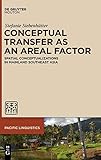Conceptual Transfer as an Areal Factor : Spatial Conceptualizations in Mainland Southeast Asia / Stefanie Siebenhütter.
Material type: TextSeries: Pacific Linguistics [PL] ; 656Publisher: Berlin ; Boston : De Gruyter Mouton, [2019]Copyright date: ©2020Description: 1 online resource (XVI, 338 p.)Content type:
TextSeries: Pacific Linguistics [PL] ; 656Publisher: Berlin ; Boston : De Gruyter Mouton, [2019]Copyright date: ©2020Description: 1 online resource (XVI, 338 p.)Content type: - 9781501515286
- 9781501506604
- 9781501506642
- 306.4460959 23
- P130.52.A785 S54 2020
- online - DeGruyter
- Issued also in print.
| Item type | Current library | Call number | URL | Status | Notes | Barcode | |
|---|---|---|---|---|---|---|---|
 eBook
eBook
|
Biblioteca "Angelicum" Pont. Univ. S.Tommaso d'Aquino Nuvola online | online - DeGruyter (Browse shelf(Opens below)) | Online access | Not for loan (Accesso limitato) | Accesso per gli utenti autorizzati / Access for authorized users | (dgr)9781501506642 |
Browsing Biblioteca "Angelicum" Pont. Univ. S.Tommaso d'Aquino shelves, Shelving location: Nuvola online Close shelf browser (Hides shelf browser)

|

|

|

|

|

|

|
||
| online - DeGruyter Managerial Decision Modeling : Business Analytics with Spreadsheets, Fourth Edition / | online - DeGruyter Cracking the Project Management Interview / | online - DeGruyter Filling Execution Gaps : How Executives and Project Managers Turn Corporate Strategy into Successful Projects / | online - DeGruyter Conceptual Transfer as an Areal Factor : Spatial Conceptualizations in Mainland Southeast Asia / | online - DeGruyter From Sounds to Structures : Beyond the Veil of Maya / | online - DeGruyter A Grammar of Kilmeri / | online - DeGruyter Staging Language : Place and Identity in the Enactment, Performance and Representation of Regional Dialects / |
Frontmatter -- Acknowledgments -- Contents -- Abbreviations -- Abstract -- 1. Encoding of spatial concepts on the Southeast Asian mainland -- 2. Mainland Southeast Asia – language area par excellence? -- 3. Factors for defining the ‘conceptual area’ -- 4. Methods -- 5. Analyzing the encoding of static spatial notions in Southeast Asia -- 6. Analysis from an onomasiological perspective -- 7. Analysis of the semasiological perspective -- 8. Text data analysis -- 9. Mainland Southeast Asia-Sprachbund par excellence -- 10. Conclusion and outlook -- Appendix -- Maps -- Tables -- Figures -- References -- Index
restricted access online access with authorization star
http://purl.org/coar/access_right/c_16ec
By analyzing conceptual transfer this volume offers new insight in areal linguistics. Mainland Southeast Asia unifies great linguistic richness consisting of numerous languages and countless varieties of genetically diverse language families. Nevertheless, the area is known as a prime example for linguistic convergence. Exemplified by spatial reference in Thai, Khmer, Lao and Vietnamese, this study reveals conceptual borrowing due to language contact as an areal defining feature. The results from the field-based data analysis may help answer what extent cultural impact can be used as evidence for the existence of linguistic areas. A speaker’s cultural background might have a stronger impact on the choice of spatial language encoding than expected. Method and structure of argumentation can provide a model for similar questions addressing the existence of linguistic areas as well as to other cognitive dimensions within the Southeast Asian area under consideration. Therefore, the study can be seen as a significant contribution to analyze possibly existing conceptual areas empirically and exemplarily. Additionally, the investigation can serve as an important complement to empirical assumptions of conceptual transfer.
Issued also in print.
Mode of access: Internet via World Wide Web.
In English.
Description based on online resource; title from PDF title page (publisher's Web site, viewed 25. Jun 2024)


